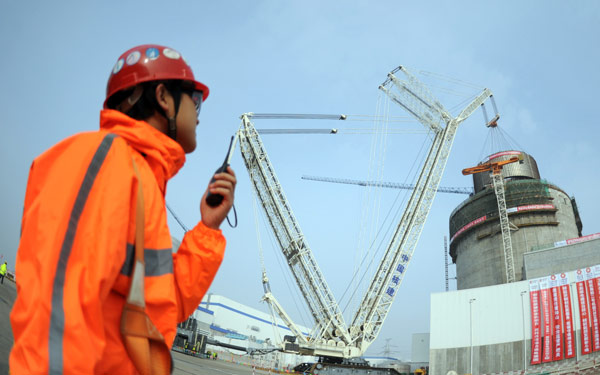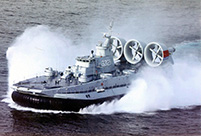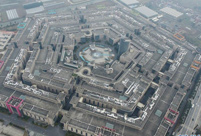

 |
| A worker talks to a crane operator with a walky-talky at a nuclear power plant construction site in Shandong province. [Photo/China Daily] |
China is planning to have at least 110 nuclear reactors running by 2030. That would make it one of the largest nuclear energy users in the world.
China also aspires to be a strong nuclear player. Hence, it is seeking to develop indigenous reactor technologies. Its three nuclear power companies are working to adapt the third-generation nuclear technology to the domestic market, so as to meet future energy needs.
The first unit of Hualong One nuclear power plant already runs on homegrown third-generation technology developed jointly by China National Nuclear Corp and China General Nuclear Power Group. Some 85 percent of such reactors can be made domestically, with a design life of 60 years.
"It is clear localization will play an increasingly important role. Domestic use of indigenous technology is a prerequisite for its export," said Yu Peigen, deputy general manager of CNNC. "If the design, software and even the fuel cannot be made domestically, how could we export our technology?"
Nestor, a Chinese-built software to design nuclear reactors, was tailor-made for Hualong One, to increase efficiency and quality of the plant construction and engineering, he said.
Nestor, he said, is analogous to the iOS operating system that powers iPhones, and is key to the third-generation nuclear technology. The software is expected to give a fillip to efforts to export China's nuclear technology.
Both CGN and CNNC have their own supply chains. So, their versions of Hualong One will differ but only slightly as the reactor design is standardized, which means 28 technical features remain the same.
CNNC is also developing a fast-neutron reactor, which belongs to the fourth-generation nuclear technology. This would enable China to depend less on imported supplies of uranium in future.
The State-backed company was behind China's first fast-neutron reactor, the China Experimental Fast Reactor, in 2011, whose operations reached full capacity in 2014.
The pool-type fast-neutron reactor has a thermal capacity of 65 mW and can produce 20 mW of electricity.
Meanwhile, the Shanghai Nuclear Engineering Research and Design Institute designed CAP1400, another third-generation nuclear reactor technology, based on the AP1000 reactor technology developed by the United States-based Westinghouse Electric Co LLC. China has promoted CAP1400 both domestically and abroad.
Zheng Mingguang, head of SNERDI, has said earlier construction of the pilot project of Shidaowan power plant in Shandong province, which will use the CAP1400 technology, is likely to start this year. There is high chance for the technology to be also used in South Africa's new-generation nuclear power stations.
"We have an edge over our competitors in terms of cost, reliability and security. Our technology incorporates both imported aspects and latest homegrown advances," he said.
 |
 A foreign girl explains what China should be proud of
A foreign girl explains what China should be proud of Chinese navy's air-cushioned landing craft in pictures
Chinese navy's air-cushioned landing craft in pictures Chinese pole dancing master opens class in Tianjin
Chinese pole dancing master opens class in Tianjin PLA holds joint air-ground military drill
PLA holds joint air-ground military drill Charming female soldiers on Xisha Islands
Charming female soldiers on Xisha Islands Beautiful skiers wear shorts in snow
Beautiful skiers wear shorts in snow Getting close to the crew on China's aircraft carrier
Getting close to the crew on China's aircraft carrier Chinese stewardess celebrate test flight at Nansha Islands
Chinese stewardess celebrate test flight at Nansha Islands Pentagonal Mart becomes the largest vacant building in Shanghai
Pentagonal Mart becomes the largest vacant building in Shanghai Top 20 hottest women in the world in 2014
Top 20 hottest women in the world in 2014 Top 10 hardest languages to learn
Top 10 hardest languages to learn 10 Chinese female stars with most beautiful faces
10 Chinese female stars with most beautiful faces China’s Top 10 Unique Bridges, Highways and Roads
China’s Top 10 Unique Bridges, Highways and Roads Virtual reality takes porn ‘to the next level’
Virtual reality takes porn ‘to the next level’ Online spat won’t hinder cross-Straits ties
Online spat won’t hinder cross-Straits ties A look behind the scenes at China’s censorship watchdog
A look behind the scenes at China’s censorship watchdog $93m gay app deal raises questions over future of LGBT services
$93m gay app deal raises questions over future of LGBT servicesDay|Week